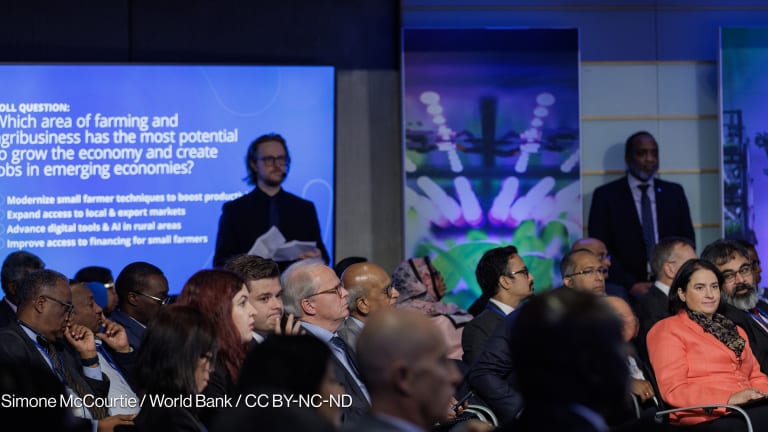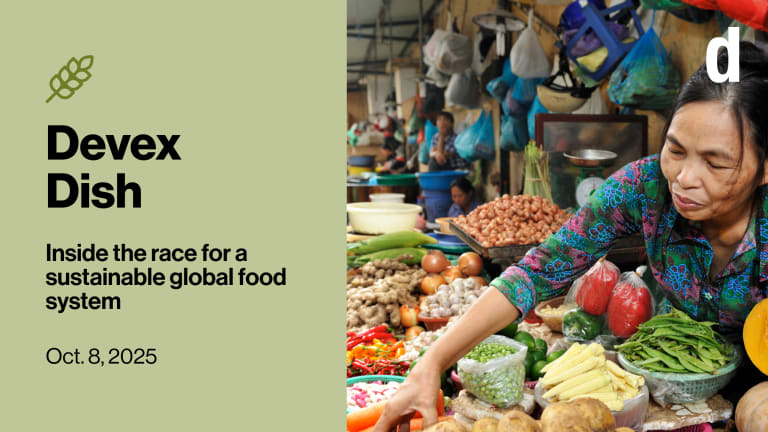How ADB plans to invest $40B in food systems by 2030
The Asian Development Bank joins the World Bank and African Development Bank in investing in food systems as a foundation of long-term economic development. A quarter of the $26 billion in additional ADB investments will go to nutrition.
The Asian Development Bank is ramping up its funding for food and nutrition security in Asia and the Pacific. At its annual meeting in Milan, Italy, this week, the bank announced it would expand its food systems investments to $26 billion by 2030, bringing its total support to $40 billion between 2022 and 2030. Of the newly announced amount, $18.5 billion will go to governments and $7.5 billion will go to private sector investments. “This expanded support will help countries alleviate hunger, improve diets, and protect the natural environment, while providing opportunities for farmers and agribusinesses,” ADB President Masato Kanda, who took office in February, told reporters in Milan on Sunday. It’s a significant acceleration of the bank’s funding in the area: In 2022, ADB had pledged to invest $14 billion by 2025 to improve food security and ease the region’s food crisis. It had committed 80% of that by the end of 2024. In Milan, the bank also unveiled several new initiatives, including the $150 million Natural Capital Fund — a blended finance mechanism targeting agrifood system investments — and a Nature and Food Partnership with the United Kingdom. ADB’s move aligns with a broader trend across multilateral development banks: The African Development Bank and World Bank are also stepping up their work on food systems and nutrition as foundations of long-term economic development. Qingfeng Zhang, ADB’s senior director of the Agriculture, Food, Nature, and Rural Development Sector Office, told Devex that the bank is betting on food systems because development in the sector contributes to so many of its other goals — including private sector investment, climate financing, inclusive development, and poverty reduction. “If you look across the board, food system transformation is going to carry all of these key targets forward,” he said. Meanwhile, Zhang said, food systems in Asia and the Pacific face growing pressure from climate change, ecosystem degradation, and trade disruptions. The region is home to more than 370 million undernourished people — over half the global total — and nearly 2 billion lack access to a healthy diet. “At the same time, the agricultural food system also carries an opportunity,” Zhang said. Agriculture currently employs 40% of the region’s workforce, and Zhang believes it will be the most promising sector for employment by 2030. The Asian Development Bank, which is headquartered in Manila, is one of the world’s largest multilateral development banks. In recent years it has also called itself the region’s climate bank, pledging to spend $100 billion on climate finance by 2030 as part of a strategy to address climate change and boost the region’s climate resilience. A relative silence fell over climate during the Milan meetings — despite many seminars exploring resilience, food systems, and sustainable development, none had the word “climate” in their titles. Climate change is exacerbating the problem of malnutrition and making it harder to solve. ADB’s investments will span agriculture value chains, rural infrastructure, environmental sustainability, social protection, and nutrition. A quarter of the new funding will go to nutrition-related projects — a priority that has long been overlooked, according to some experts. At the Nutrition for Growth, or N4G, summit in Paris, France, in March, Nutrition International and ADB signed a seven-year partnership aimed at boosting nutrition security in Asia by prioritizing it across ADB’s investments across various sectors — from education to social protection to natural resource management — as well as research and advocacy on nutrition. “If you look through that lens across the totality of the social sector lending portfolio of an MDB, across agriculture, water and sanitation, health, education, social protection, in many ways it’s a map of missed opportunities for nutrition,” Joel Spicer, the CEO of Nutrition International, told Devex during N4G. Spicer said that when he worked as a senior health specialist at the World Bank, he noticed how many social sector programs missed opportunities because they didn’t consider nutrition in their project designs. ADB deals with both ends of the malnutrition spectrum: Pacific island nations account for some of the highest obesity rates in the world, while other countries in Asia and the Pacific grapple with high obesity rates. “Because we’re a development bank, we’re not used to feeding the hungry. That's not our job: It’s economic development,” F. Cleo Kawawaki, ADB’s director general of the Sectors Department 2, which manages operations for the agriculture, food, nature, rural development, water, urban development, and digital sectors, told Devex during N4G. But there’s growing consensus that nutrition investments aren’t just morally compelling — they’re also smart economics. According to the World Bank’s Investment Framework for Nutrition 2024, every $1 invested in addressing undernutrition has an expected return of $23. “We do feel that with the investment in nutrition, you're maximizing the value of the most important resource you have, that is human capital,” Kawawaki said. “We’ve been spending years and years and years investing in education, investing in health, but then we do know that the first 1,000 days of a child’s life is most important to prevent stunting.” If you invest in education but not in preventing malnutrition, she added, you’re already limiting some children’s options. “In order to have the human capital to reach its maximum potential, you need to have not only food security, but nutrition security and healthy diets.” Challenges remain because of how interwoven nutrition is with cultural, logistical, and other development challenges such as access to clean water and sanitation and infrastructure. “It’s not like you build a power plant, get electricity, and boom, that's resolved,” Kawawaki said. But Spicer said momentum is building. He said Nutrition International has been supporting the African Development Bank’s work on the subject in the last five years, and he’s seen its portfolio value of nutrition-smart projects increase by billions of dollars. “There’s much more that needs to be done and change takes time but it’s a start,” he said. “When MDBs are talking about nutrition as an investment, and the country voices from the nutrition community are talking about the cost of inaction and moving from an aid mode to an investment mode in nutrition financing — you know things are moving in the right direction.”
The Asian Development Bank is ramping up its funding for food and nutrition security in Asia and the Pacific.
At its annual meeting in Milan, Italy, this week, the bank announced it would expand its food systems investments to $26 billion by 2030, bringing its total support to $40 billion between 2022 and 2030. Of the newly announced amount, $18.5 billion will go to governments and $7.5 billion will go to private sector investments.
“This expanded support will help countries alleviate hunger, improve diets, and protect the natural environment, while providing opportunities for farmers and agribusinesses,” ADB President Masato Kanda, who took office in February, told reporters in Milan on Sunday.
This story is forDevex Promembers
Unlock this story now with a 15-day free trial of Devex Pro.
With a Devex Pro subscription you'll get access to deeper analysis and exclusive insights from our reporters and analysts.
Start my free trialRequest a group subscription Printing articles to share with others is a breach of our terms and conditions and copyright policy. Please use the sharing options on the left side of the article. Devex Pro members may share up to 10 articles per month using the Pro share tool ( ).
Alessio Perrone is a freelance editor and reporter at Devex. Throughout his career, he has reported on issues at the intersection of policy, environment and human interest for outlets including The Guardian, Scientific American, TIME, and others. He’s based in Milan, Italy.








